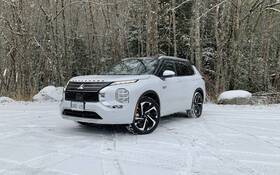2023 Mitsubishi Outlander PHEV: The Evolution of a Pioneer

| Strong points |
|
|---|---|
| Weak points |
|
2018 feels like yesterday, literally. Yet, in just a few years, the automotive market has radically evolved, so much that the compact plug-in hybrid SUV segment has reached maturity. The Mitsubishi Outlander PHEV hit the North American market at the beginning of that very year. And even if the automaker seemed to be lagging in recent years, introducing this first affordable plug-in hybrid SUV was definitely a big hit. While other manufacturers have since joined the party, the Outlander PHEV enters a new generation for 2023.
Here's the full report on our first driving impressions.
More Power, Better Range
For the 2022 model year, Mitsubishi had a new generation of the Outlander in store with an anticipated model that was developed jointly with the Nissan Rogue. While the Outlander was, well, very old, it has managed to make up for lost time. The 2023 Outlander PHEV is equipped with a 2.4 L naturally aspirated four-cylinder engine which saw its power output increased from 126 to 131 horsepower. As for the electric motors, their output has also been increased. In the front, the horsepower jumps from 80 to 114, while in the rear, the horsepower increases from 94 to 134. The new Outlander PHEV is certainly not a sprinter like the Toyota RAV4 Prime, but it shows significant improvements over the outgoing model.
In any case, who really needs 301 horsepower in a compact SUV?

If the improvements are noticeable on the powertrain side, it's also the case for the battery. The previous model had a 13.8 kWh battery. Its capacity is now 20 kWh with a 61-kilometre range in all-electric mode. During our test, however, we drained the battery after driving 36.9 kilometres in the Greater Vancouver area. The trip computer showed an unusually high 35.7 kWh/100 km.
It should be noted that the outside temperature was hovering around the freezing point and that the proposed route was quite choppy. But we weren’t too sudden on the accelerator in any way. On the other hand, we were able to play around with the driving mode that allows the battery to store energy. Over a distance of 87 kilometres, we were able to recover enough energy to cover, in theory, 38 kilometres. However, during this time, we were not optimizing fuel consumption.

At the end of our 157-kilometre test, the on-board computer showed a fuel consumption of 8.1 L/100 km. Natural Resources Canada reports a combined rating of 9.0 L/100 km. In the end, the Outlander is handicapped by an outdated gasoline engine.
Of course, this rating could be greatly reduced if you only drive about 50 kilometres a day and have access to a charging station at your home or workplace, enabling you to go several weeks without having to stop at a gas station! The Outlander PHEV is equipped with the all-wheel drive system called Super All-Wheel Control. Although conditions didn't allow us to put this system to the test, its effectiveness has long been proven...
A Third Row of Seats
In the compact SUV segment, very few models offer a third row of seats. In fact, only the Volkswagen Tiguan and Mitsubishi Outlander have them and they are among the largest SUVs in the segment. The Outlander is defined as a 5+2 SUV: it can comfortably accommodate five occupants two additional occupants can sit in the third row. But not only are these seats difficult to access, they aren’t very comfortable, with several inches of head and legroom missing for an average adult. In the front, however, the Outlander is comfortable and we liked the driving position. We also noticed an improvement in the soundproofing of the cabin. The infotainment system, shared with Nissan, is also a huge step forward compared to the previous generation model.

Autrement, l’Outlander est confortable et la position de conduite nous a plu. Nous avons également constaté une amélioration sur le plan de l’insonorisation de l’habitacle. Le système d’infodivertissement, partagé avec Nissan représente également un immense pas en avant par rapport au modèle de précédente génération.
$10,000 in Government Credits
For 2023, the Outlander PHEV starts at $46,538. You’ll have to dish out $51,248 for an LE version that gets three-zone climate management, panoramic roof, 360-degree camera, heated steering wheel, power driver's seat and the nine-inch screen. We don't see the point of opting for a more equipped version that will be considerably more expensive. The range-topping GT Premium variant with two-tone paint costs $57,948. The good news is that the 2023 Outlander PHEV is eligible for the $5,000 provincial and $5,000 federal incentives, for a total of $10,000. The previous model was only eligible for a total of $5,000.00.

The Final Word
The Mitsubishi Outlander PHEV had no rivals when it arrived on the market. Immensely important to the automaker, it attracted a new clientele that would never have thought to set foot in a Mitsubishi dealership. Over time, the Toyota RAV4 Prime, Ford Escape PHEV, Hyundai Tucson PHEV and Kia Sportage PHEV have joined the ranks of this now-popular niche. Today, the competition is fierce, and the second-generation Mitsubishi Outlander PHEV has what it takes to keep the momentum going and maintain its market share. Let's hope that Mitsubishi has planned for this and has developed a strategy to avoid long waiting lists...











